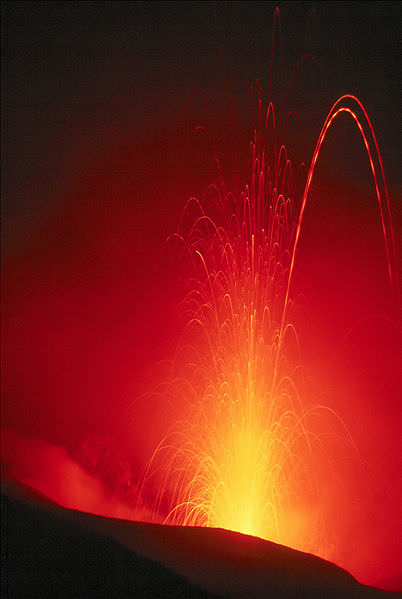[/caption]
The ground beneath your feet feels cool, but you’re actually standing on a thin shell of crust around the much hotter mantle of the Earth. The mantle is under such pressure and temperature that rock squeezes out as a liquid and makes its way to the surface. When the magma reaches the surface, it’s called a volcanic eruption, and can spew out as lava, ash and even large volcanic rocks.
There are actually different kinds of volcanic eruptions, depending on the chemical nature of the magma itself.
The most powerful volcanic eruptions are known as Plinian eruptions, and they involved the explosion ejection of viscous (very thick) lava. A well known example of this is the eruption of Mount Saint Helens in 1980, or Pinatubo in the Philippines.
In a Strombolian eruption, clots of lava blast out of volcano caldera and make arcs through the sky before raining down around the volcano. The lava can continue to stream down the sides of the volcano like tiny rivers causing more damage.
In a Vulcanian eruption, a dense cloud of ash blasts out of the volcano and rises dozens of kilometers into the atmosphere above the peak.
In a Vesuvian eruption, the ash cloud doesn’t rise as high, and forms more of a cauliflower-shaped plume above the volcano peak. This type of volcanic eruption was named after Mount Vesuvius, which destroyed two Roman towns in 79 AD.
During a Pelean eruption, large quantities of ash, rock and dust are blasted out of a central crater and then travel down the slopes of the volcano and hundreds of kilometers per hour. These are one of the most dangerous kinds of volcanic eruptions, as they can lead to a tremendous loss of life to towns and villages near the volcano.
A Hawaiian eruption is when lava comes out of linear vents, and joins together to form streams and rivers of lava. The lava can even come out of the ground at such speed that it creates fountains that erupt for dozens of meters into the air.
Phreatic eruptions are also known as steam blast eruptions, and are caused by expanding steam beneath the ground created when water comes in contact with hot rock or magma.
We have written many articles about volcanoes for Universe Today. Here’s an article about different types of volcanoes, and here’s an article about different types of lava.
Want more resources on the Earth? Here’s a link to NASA’s Human Spaceflight page, and here’s NASA’s Visible Earth.
We have also recorded an episode of Astronomy Cast about Earth, as part of our tour through the Solar System – Episode 51: Earth.
References:
http://www.uwsp.edu/geo/faculty/ritter/geog101/textbook/volcanic_landforms/volcano_hazards.html
http://vulcan.wr.usgs.gov/Volcanoes/Italy/description_italy_volcanics.html

